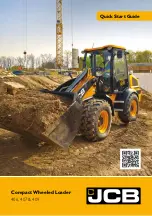
8-6
OPTIONS
QUICK-COUPLERS
• Oil may spurt out if the caps or filters
are removed or pipes disconnected
before releasing the pressure in the
hydraulic system.
· When removing plugs or screws, or
when disconnecting hoses, stand to
the side and loosen them slowly to
gradually release the internal pressure
before removing.
• Do not release pressure:
· When the attachment is not in the rest
position.
· During operation of the attachment.
(Due to danger of unexpected
movement of the attachment)
• Do not couple or uncouple when there
is a flow or pump pressure in the circuit.
Disconnection or connection is allowed
only when there is no residual pressure.
• Hydraulic fluid, tubes, fittings and
quick-couplers can get hot when
running machine and attachments. Be
careful when connecting and
disconnecting quick-couplers.
IMPORTANT: When the couplings are
disconnected, it is suggested to use the
protection caps.
IMPORTANT: Before uncoupling, be sure
to release the residual pressure.
QUICK-COUPLERS
Releasing residual pressure
Coupling and uncoupling
1. Before coupling, clean the flat mating surfaces
of quick coupling to avoid the inclusion of dirt
into the circuit.
2. Release the residual pressure from the upper
coupling (a) by pulling the knob (1) outward
first and then upward. Release the residual
pressure from the lower coupling (b) by pulling
the knob (1) outward first and then downward.
3. To couple, push the male half towards the
female half or vice versa.
4. To uncouple, pull back in sleeve of the female.
Connecting the hydraulic circuits
To connect the attachment hydraulic lines,
use the following procedures:
1. Connect the attachment hydraulic lines to
ports (a) and (b).
When fitted with a hydraulic breaker:
a. Connect the return circuit to port (b)
and the supply circuit to port (a).
b. Turn on the flow selector switch and
select “one-way”.
Some attachments may have a case
drain, which needs to be connected to
the small port (T).
2. When connecting is complete, purge air
from the hydraulic lines.
a. Start and run the engine at low idle with
no load for 10minutes.
b. With the engine running at low idle,
operate the auxiliary hydraulics switch
repeatedly (approx. 10 times) to purge
air from the hydraulic lines.
c. Stop the engine and wait for more than
5 minutes until bubbles escape from the
hydraulic oil in the tank.
Summary of Contents for TL8
Page 1: ......
Page 7: ...0 5...
Page 12: ...0 10...
Page 13: ...1 1 SAFETY...
Page 55: ...1 43 SAFETY SAFETY SIGNS DECALS With Lift arm lower button TL10 TL12...
Page 56: ...1 44 SAFETY SAFETY SIGNS DECALS...
Page 57: ...1 45 SAFETY SAFETY SIGNS DECALS...
Page 58: ...1 46 SAFETY SAFETY SIGNS DECALS...
Page 59: ...2 1 CONTROLS...
Page 113: ...3 1 OPERATION...
Page 119: ...3 7 MEMO...
Page 143: ...4 1 TRANSPORT...
Page 148: ...4 6...
Page 149: ...5 1 MAINTENANCE...
Page 211: ...6 1 TROUBLESHOOTING...
Page 234: ...6 24...
Page 235: ...7 1 SPECIFICATIONS...
Page 239: ...7 5 MEMO...
Page 240: ...7 6 SPECIFICATIONS MACHINE DIMENSIONS MACHINE DIMENSIONS...
Page 243: ...7 9 MEMO...
Page 244: ...7 10 SPECIFICATIONS OPERATING RANGES OPERATING RANGES...
Page 246: ...7 12...
Page 247: ...8 1 OPTIONS...
Page 261: ...8 15...
































